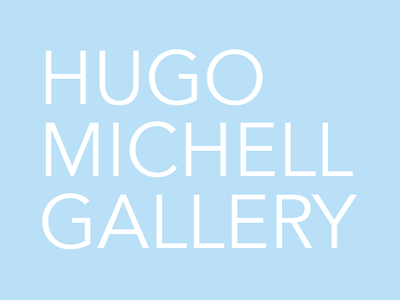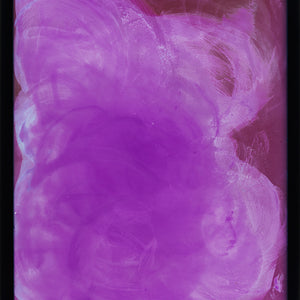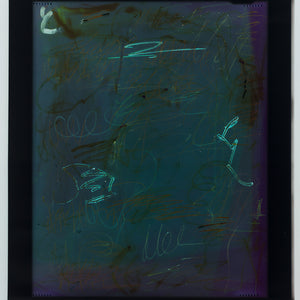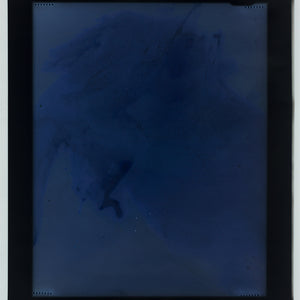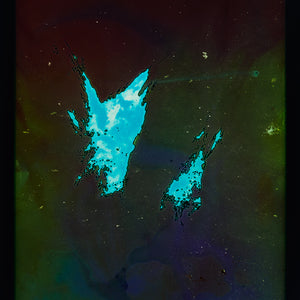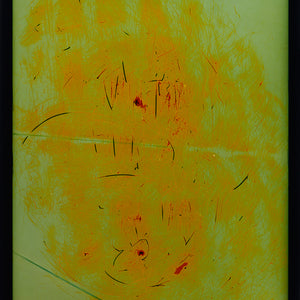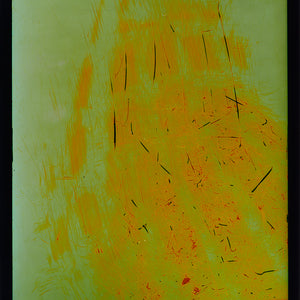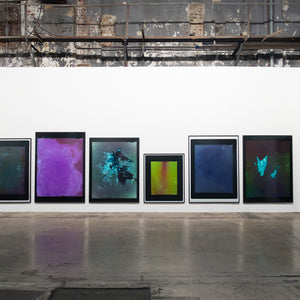'Maternal Line' Artist Statement
What is the transaction that takes place when a photographic portrait is made? This question is key to understanding Maternal Line, a photograph I made earlier this year and submitted to the Olive Cotton Award for photographic portraiture.
The form of my work is often determined by the circumstances in which I am living and working. At the moment, I am spending a lot of time living with my grandmother and so I get to closely observe her. I try and make my photography an extension of my life, not something that is separate from it. Photography is something that is always with me; in fact, I can safely say that my entire way of being is centered on it. In this instance, I brought a piece of light-sensitive photographic film, a negative, into my grandmother’s home and had her leave her own inscriptions on it. She was testing some pens on a piece of paper and I asked her to continue on my piece of film. Her actions, so redolent of her character, of her love of doing things, of her way of always keeping busy, allowed me to conjure out of a piece of light-sensitive film a powerful portrait of the kind of person she is. I also chose this action because I wanted the marks that she made onto the negative surface to be automatic; I didn’t want her to get in the way of herself by feeling like she had to perform and make a work of art.
I also asked her to smear some of her saliva on the film. This was for a reason. What is this bodily fluid evidence of, but her genetic code and trace? Is that not what we seek within each and every photograph of somebody, especially those we love? So this film became a portrait of her, of the signature moves of her hand and of a trace of her body. But it is also a portrait of our relationship, of our collaboration, of an exchange between us. So, two people are represented in the photograph that has resulted, and perhaps even more. For, when you think about it, maternal lines intersect with paternal lines: what do they comprise of but the bodies of men and women coming together? So, I think it is fair to say that, much like the trace of my grandmother’s hand and its commingling with her saliva, the bodies of men and women occupy my photograph together; just as we all carry x and y chromosomes within and as us.
When I was conceiving the photograph, for these reasons, I actually thought of the work as a family portrait, but through the maternal line. So, why my grandmother and not my grandfather? That’s simple: I have no surviving grandfather. My grandmother, born in Hungary, is the most senior surviving member of my family on either my maternal or paternal sides. I am indeed very close to her and wanted to celebrate her strength of character, which I also recognise as contributing to my own strength.
The piece of film was exposed to light for a long time, and yet, when printed, it still reveals much of what it has endured during this extended duration. It has died, over-exposed, and then come back to life. I printed it at a large scale, so that its swathes of colour immerse the viewer. It is larger than life. It is a portrait, but not a simple one, not simply a likeness of a single person, more an evocation of a relationship between people, between two women. When we think about photographs of a woman, we tend to make a judgment of her exterior. By making a portrait in which a female subject traces herself with pen and saliva onto a photographic surface, this work defies such scrutiny. My grandmother didn’t have the anxiety (that I know she would have felt), if I had used a camera. In this case, my grandmother was not the passive object of my photography but a participant in its making.
But what is the photographic object that we are looking at when we view Maternal Line? Are we simply looking at hand-made inscriptions and saliva? Are we only viewing the negative that these gestures were made upon? We are viewing these elements; however, they are mediated through a photographic print. This is the crucial element that has been missing from much of the conversation about Maternal Line. I think this is due to the way the majority of us view photographs as “windows onto another place”, even though we are actually looking at a photographic impression manifested on (in this case) a paper substrate. My photography is consciously pointing to what is clearly before us but more often than not is also a victim to blindness (I find this quite interesting when we recognise the ubiquitousness of photographic imagery).
To achieve this combination of looking through and looking at, I spend just as much time printing in a darkroom as I do exposing my negatives (these two things are what comprises my profession, which for me is a full-time occupation). This means I spend many hours with my printer making my analogue photographic prints in a photographic lab. Through this process I get to know the image I am working with intimately and also get to play with the form of photograph. The black bordering that we view around Maternal Line is not simply decorative but is an element that points to its photographicness; this margin is made by the enlarger as light passed through the negative and onto photographic paper.
As with all of my photography, there was only one attempt at capturing my grandmother onto the negative surface. This is because my photography is about the action it is recording and not what looks most aesthetically pleasing: it simply is what it is. With the trace of her hand and a touch of her saliva my grandmother is here manifest within and as the photograph. In other words, there is no separation between her and the photographic object. When she is no longer of this world I will still always have her with me. If you close your eyes and imagine a loved one, I can almost guarantee that the impression you will find won’t be crisp and clear; it will be muffled and somewhat muted, just a memory of a gesture or the sound of a laugh; yet somehow you know it is them. My photography seeks to evoke this kind of sensation. I can’t express how close I feel to my grandmother when I view Maternal Line. Through it, I am nearer to her than when I look at any of the many lens-based photographs I have of her. I hope that others will be able to share this same sense of closeness in front of the photograph she and I have made together.
